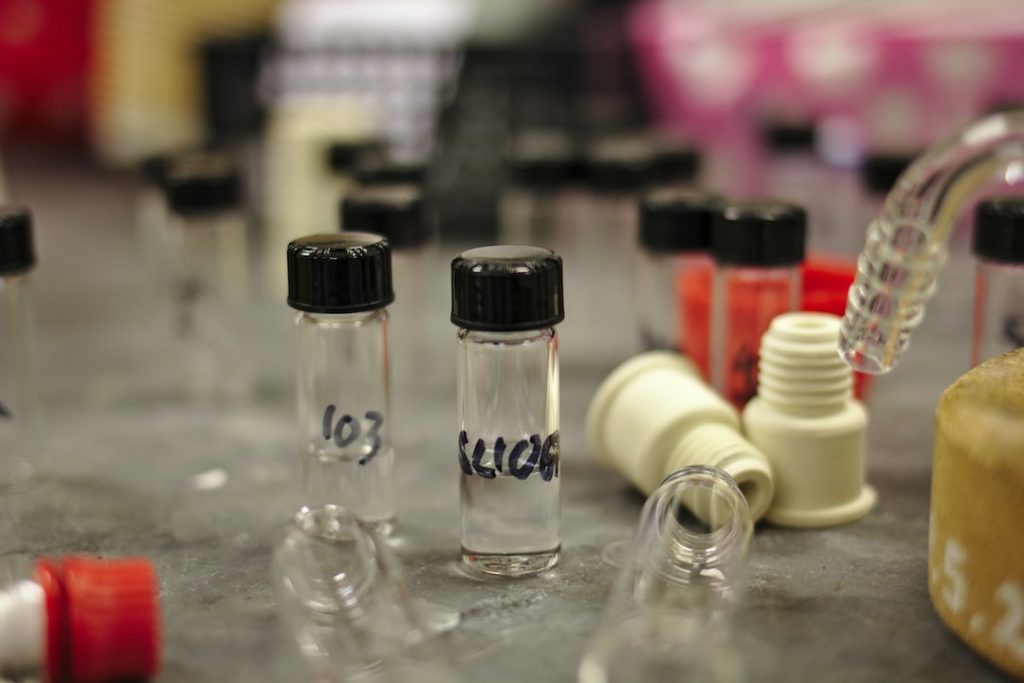Inorganic chemistry is the branch of chemistry that deals with the study of inorganic compounds, which are substances that do not contain carbon-hydrogen bonds. It focuses on the properties and behavior of inorganic compounds, as well as their synthesis and applications. Inorganic chemistry plays a crucial role in various fields, including materials science, pharmaceuticals, environmental science, and industry.
Key Takeaways
- Inorganic chemistry is the study of elements and compounds that do not contain carbon.
- The periodic table is a tool used to organize and classify elements based on their properties.
- Chemical bonding is the force that holds atoms together in a molecule or compound.
- Inorganic compounds have unique physical and chemical characteristics that make them useful in a variety of applications.
- Inorganic reactions involve the combination and reaction of elements to form new compounds.
- Inorganic chemistry has applications in materials science, pharmaceuticals, manufacturing, and environmental remediation.
- The role of inorganic chemistry in industry is important for the production of goods and materials.
- Inorganic chemistry can have negative environmental impacts, but can also be used to remediate pollution.
- Inorganic chemistry is present in everyday household products and consumer goods.
- Future directions in inorganic chemistry include emerging technologies and research areas such as nanotechnology and renewable energy.
The Periodic Table: A Guide to the Elements of Inorganic Chemistry
The periodic table is a systematic arrangement of elements based on their atomic number, electron configuration, and recurring chemical properties. It provides a comprehensive guide to the elements and their properties, allowing scientists to understand and predict the behavior of different elements and their compounds.
The periodic table is divided into groups and periods. Groups represent elements with similar properties, while periods represent elements with increasing atomic numbers. Each element is represented by a symbol and is accompanied by its atomic number and atomic mass.
The periodic table is an essential tool in inorganic chemistry as it helps scientists understand the trends and patterns in the properties of elements. It allows them to predict the reactivity, chemical bonding, and physical characteristics of different elements and their compounds. For example, elements in the same group tend to have similar chemical properties, while elements in the same period tend to have similar atomic sizes.
Chemical Bonding: Understanding the Forces that Hold Atoms Together
Chemical bonding refers to the forces that hold atoms together to form molecules or compounds. There are three main types of chemical bonds: ionic bonds, covalent bonds, and metallic bonds.
Ionic bonds occur when there is a transfer of electrons from one atom to another. This results in the formation of positively charged ions (cations) and negatively charged ions (anions), which are held together by electrostatic forces.
Covalent bonds occur when atoms share electrons to achieve a stable electron configuration. This type of bonding is commonly found in organic and inorganic compounds.
Metallic bonds occur when there is a sharing of electrons between metal atoms. This results in the formation of a lattice structure, where the electrons are delocalized and can move freely throughout the structure.
Chemical bonding is crucial in inorganic chemistry as it determines the stability, reactivity, and physical properties of compounds. It allows scientists to understand how elements combine and interact with each other, leading to the development of new materials, catalysts, and drugs.
Properties of Inorganic Compounds: Physical and Chemical Characteristics
| Property | Description |
|---|---|
| Melting Point | The temperature at which a solid inorganic compound melts and becomes a liquid. |
| Boiling Point | The temperature at which a liquid inorganic compound boils and becomes a gas. |
| Solubility | The ability of an inorganic compound to dissolve in a solvent. |
| Conductivity | The ability of an inorganic compound to conduct electricity. |
| Reactivity | The tendency of an inorganic compound to undergo a chemical reaction. |
| Acidity/Basicity | The ability of an inorganic compound to act as an acid or a base. |
| Density | The mass per unit volume of an inorganic compound. |
| Crystal Structure | The arrangement of atoms or molecules in a solid inorganic compound. |
Inorganic compounds exhibit a wide range of physical and chemical properties. Physical properties include characteristics such as melting point, boiling point, density, solubility, and conductivity. Chemical properties refer to the behavior of compounds in chemical reactions, such as their reactivity, stability, and ability to form complexes.
Inorganic compounds can be classified into several categories based on their properties. For example, metal oxides are known for their high melting points, hardness, and electrical conductivity. Non-metal oxides, on the other hand, tend to be gases or liquids at room temperature and are often acidic.
Inorganic compounds also play a crucial role in various industries. For example, titanium dioxide is widely used as a white pigment in paints, plastics, and cosmetics due to its high refractive index and opacity. Sodium chloride is used as a preservative and flavor enhancer in food products due to its ability to enhance taste and preserve freshness.
Understanding the properties of inorganic compounds is essential in inorganic chemistry as it allows scientists to design and synthesize new materials with specific properties for various applications.
Inorganic Reactions: How Elements Combine and React with Each Other
Inorganic reactions involve the combination or rearrangement of elements to form new compounds. These reactions can be classified into several types, including precipitation reactions, acid-base reactions, redox reactions, and complexation reactions.
Precipitation reactions occur when two aqueous solutions react to form an insoluble solid, known as a precipitate. This type of reaction is commonly used in analytical chemistry to identify and separate different ions in a solution.
Acid-base reactions involve the transfer of protons from an acid to a base. This results in the formation of a salt and water. Acid-base reactions are fundamental in many chemical processes, including industrial manufacturing and biological systems.
Redox reactions involve the transfer of electrons between reactants. Oxidation refers to the loss of electrons, while reduction refers to the gain of electrons. Redox reactions are essential in energy production, such as in batteries and fuel cells.
Complexation reactions occur when a metal ion forms a complex with one or more ligands. Ligands are molecules or ions that donate electrons to the metal ion, forming coordinate bonds. Complexation reactions are important in coordination chemistry and have applications in catalysis, medicine, and environmental science.
Inorganic reactions are crucial in inorganic chemistry as they allow scientists to understand how elements combine and interact with each other. They provide insights into the mechanisms and kinetics of chemical reactions, leading to the development of new catalysts, drugs, and materials.
Applications of Inorganic Chemistry: From Materials Science to Pharmaceuticals

Inorganic chemistry has numerous applications in various fields, including materials science, pharmaceuticals, environmental science, and energy production.
In materials science, inorganic chemistry is used to design and synthesize new materials with specific properties for various applications. For example, semiconductor materials such as silicon and gallium arsenide are used in electronic devices like transistors and solar cells. Superconducting materials such as yttrium barium copper oxide are used in high-speed trains and magnetic resonance imaging (MRI) machines.
In pharmaceuticals, inorganic chemistry plays a crucial role in the development of new drugs and therapies. Metal-based drugs, known as metallodrugs, have shown promise in the treatment of cancer, bacterial infections, and neurological disorders. For example, cisplatin is a platinum-based drug used in chemotherapy to treat various types of cancer.
In environmental science, inorganic chemistry is used to study and mitigate the impact of pollutants on ecosystems. It helps scientists understand the behavior and fate of heavy metals, such as lead and mercury, in the environment. Inorganic chemistry also plays a role in wastewater treatment, air pollution control, and soil remediation.
In energy production, inorganic chemistry is used to develop new materials for energy storage and conversion. For example, lithium-ion batteries rely on the electrochemical reactions between lithium ions and transition metal oxides. Inorganic chemistry also plays a role in the development of fuel cells, solar cells, and hydrogen production technologies.
The Role of Inorganic Chemistry in Industry: Manufacturing and Production
Inorganic chemistry plays a crucial role in industry, particularly in manufacturing and production processes. It is used to develop new materials, improve efficiency, and ensure product quality.
Inorganic chemistry is involved in the synthesis and production of various chemicals and materials used in industry. For example, ammonia is produced through the Haber-Bosch process, which involves the reaction between nitrogen gas and hydrogen gas over an iron catalyst. Ammonia is a key ingredient in fertilizers, explosives, and cleaning products.
Inorganic chemistry is also used in the production of metals and alloys. Metallurgical processes such as smelting, refining, and alloying rely on inorganic chemistry principles to extract metals from ores and produce high-quality alloys for various applications.
In addition to manufacturing processes, inorganic chemistry is also important in quality control and product testing. It helps ensure that products meet safety standards and regulatory requirements. For example, inorganic chemistry techniques such as atomic absorption spectroscopy and X-ray diffraction are used to analyze the composition and structure of materials.
Environmental Impacts of Inorganic Chemistry: Pollution and Remediation
Inorganic chemistry has both positive and negative impacts on the environment. While it has contributed to technological advancements and improved living standards, it has also led to pollution and environmental degradation.
Pollution caused by inorganic chemistry can occur through various pathways, including industrial emissions, improper waste disposal, and accidental spills. Heavy metals, such as lead, mercury, and cadmium, are common pollutants that can have detrimental effects on ecosystems and human health.
Remediation is an important aspect of inorganic chemistry that focuses on the cleanup and restoration of polluted environments. It involves the development and application of techniques to remove or neutralize pollutants. For example, in situ chemical oxidation is a remediation technique that involves the injection of oxidizing agents into contaminated soil or groundwater to degrade organic pollutants.
Inorganic chemistry also plays a role in environmental monitoring and risk assessment. It helps scientists understand the behavior and fate of pollutants in the environment, as well as their potential impacts on ecosystems and human health. This information is crucial for developing effective strategies for pollution prevention and control.
Inorganic Chemistry in Everyday Life: Household Products and Consumer Goods
Inorganic chemistry has a significant impact on everyday life through its applications in household products and consumer goods. Many products that we use on a daily basis rely on inorganic compounds for their functionality and performance.
Cleaning products such as detergents, bleaches, and disinfectants often contain inorganic compounds such as sodium hypochlorite, hydrogen peroxide, and ammonia. These compounds help remove stains, kill bacteria, and sanitize surfaces.
Personal care products such as toothpaste, deodorants, and sunscreens also rely on inorganic compounds for their properties. For example, titanium dioxide and zinc oxide are commonly used in sunscreens due to their ability to absorb and reflect UV radiation.
Inorganic compounds are also used in the production of construction materials such as cement, glass, and ceramics. Cement, for example, is made from a mixture of calcium silicates and other inorganic compounds. Glass is made from silica, soda ash, and limestone, while ceramics are made from clay and other minerals.
Future Directions in Inorganic Chemistry: Emerging Technologies and Research Areas
Inorganic chemistry continues to evolve and expand, with new research areas and emerging technologies on the horizon. Scientists are exploring new materials, catalysts, and processes that have the potential to revolutionize various industries.
One emerging research area in inorganic chemistry is the development of sustainable materials and technologies. This includes the use of renewable resources, such as biomass and carbon dioxide, as feedstocks for the production of chemicals and materials. It also involves the development of energy-efficient processes and the reduction of waste and emissions.
Another research area is the development of advanced functional materials with unique properties. This includes materials with enhanced conductivity, magnetism, catalytic activity, or optical properties. These materials have applications in electronics, energy storage, sensing, and environmental remediation.
Nanotechnology is another area of interest in inorganic chemistry. It involves the manipulation and control of matter at the nanoscale to create new materials with unique properties. Nanomaterials have applications in electronics, medicine, environmental science, and many other fields.
Continued research in inorganic chemistry is crucial for addressing global challenges such as climate change, energy security, and public health. It provides the foundation for technological advancements and innovations that can improve our quality of life while minimizing our impact on the environment.
Inorganic chemistry plays a vital role in various fields and industries. It provides insights into the behavior and properties of inorganic compounds, allowing scientists to design new materials, develop new drugs, and improve manufacturing processes. Inorganic chemistry also has environmental implications, as it helps us understand and mitigate the impact of pollutants on ecosystems. Furthermore, inorganic chemistry is present in our everyday lives through the products we use and the materials we rely on. Continued research and interest in inorganic chemistry are essential for addressing global challenges and driving technological advancements.
FAQs
What is Inorganic Chemistry?
Inorganic chemistry is the study of the properties and behavior of inorganic compounds, which are compounds that do not contain carbon-hydrogen bonds.
What are some examples of inorganic compounds?
Some examples of inorganic compounds include salts, metals, minerals, acids, and bases.
What is the difference between organic and inorganic chemistry?
Organic chemistry is the study of carbon-containing compounds, while inorganic chemistry is the study of compounds that do not contain carbon-hydrogen bonds.
What are the applications of inorganic chemistry?
Inorganic chemistry has many applications, including the development of new materials, catalysts, drugs, and electronic devices.
What are some subfields of inorganic chemistry?
Some subfields of inorganic chemistry include bioinorganic chemistry, materials chemistry, solid-state chemistry, and coordination chemistry.
What are some techniques used in inorganic chemistry?
Some techniques used in inorganic chemistry include X-ray crystallography, spectroscopy, electrochemistry, and computational chemistry.
What are some challenges in inorganic chemistry?
Some challenges in inorganic chemistry include understanding the electronic structure and bonding of complex inorganic compounds, developing new catalysts for chemical reactions, and designing new materials with specific properties.


